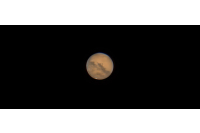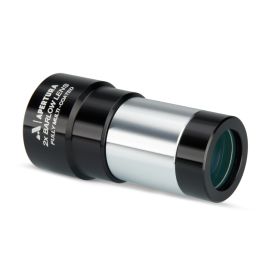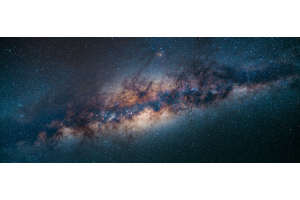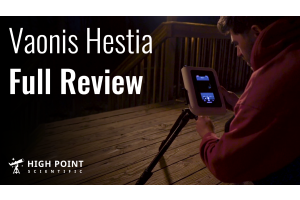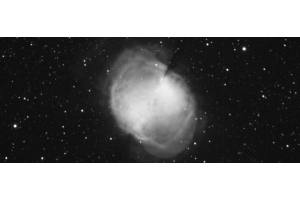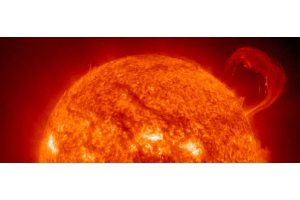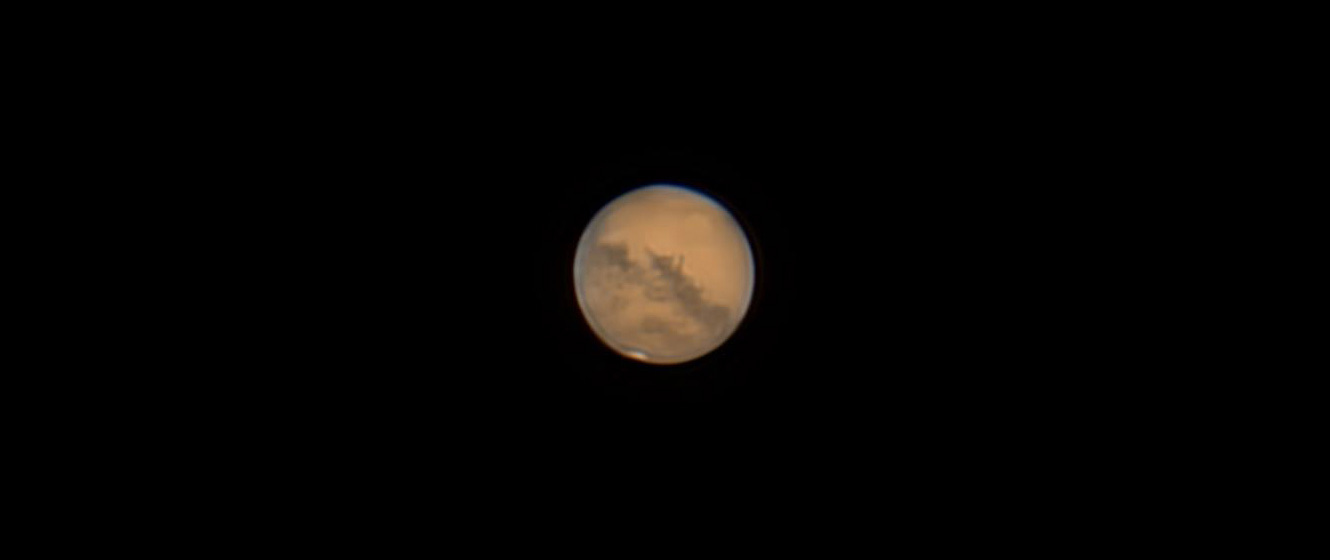
In late July of this year, there is an exciting opportunity to see Mars at its best! The “Red Planet” will be at opposition, which means it will be opposite the Sun as observed from Earth. At a distance of only 35.8 million miles, it will be closer to Earth than it has been in the past 15 years, and it won't be this well placed again until 2035.
There is no need to wait until July 27, when Mars is at opposition, to dust off your telescope, however, because the planet will look spectacular for weeks before and after this date. At this time Mars will shine nearly as brightly as Jupiter and, to the naked eye, will appear like a bright "star" in the sky.
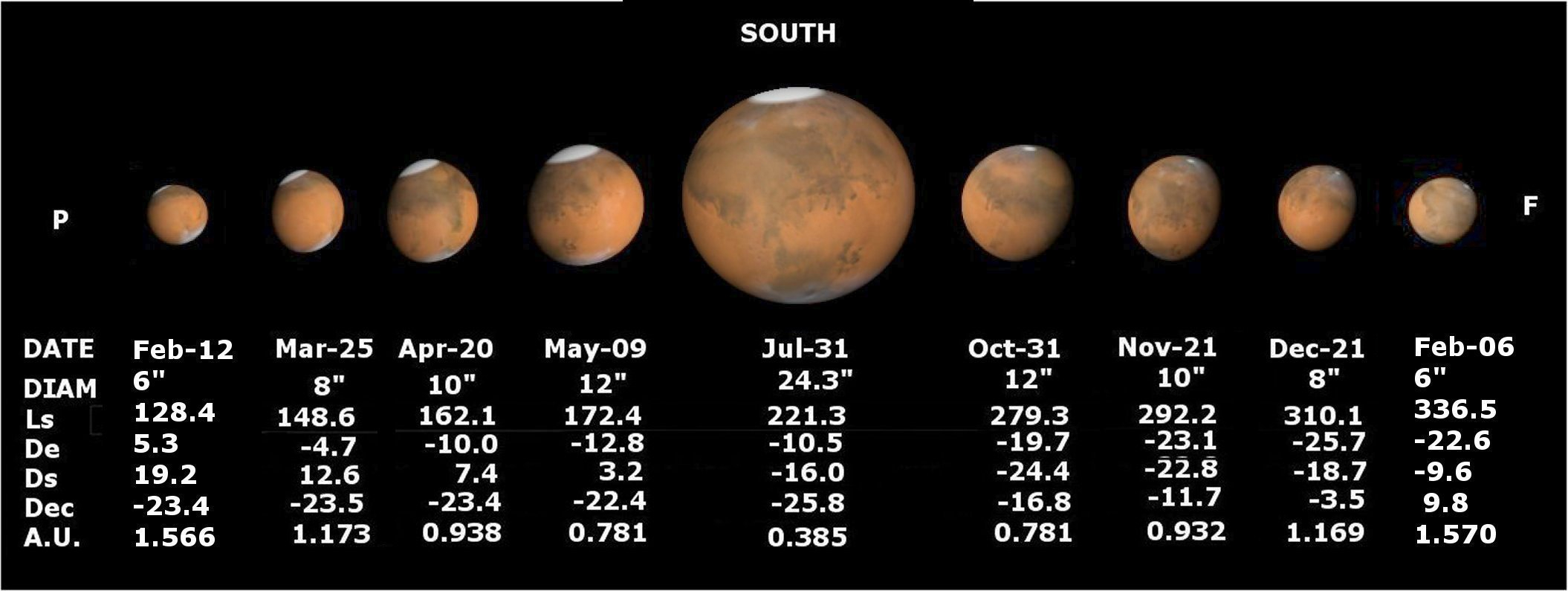
The apparent size of Mars from February 2018 - February 2019. Image by ALPO
Planetary observing can be a very rewarding part of our hobby and, unlike deep sky observing, where sky transparency is of paramount importance, the planets can be enjoyed almost anywhere, even in light-polluted cities, as long as the seeing is steady with very little atmospheric turbulence. It's also nice to know that because the planets that show the most details (Jupiter, Saturn, and Mars) are so bright, setting circles, computerized mounts, and star hopping techniques aren’t needed for planetary observations.
What can an observer expect to see on Mars with a telescope during this time? Even a high-quality telescope as small as 75 mm, used on a steady night, should reveal some of the major details on Mars, including polar caps of frozen carbon dioxide and water ice as well as lighter and darker regions which represent real surface features on the planet's disc. Obviously, larger telescopes will show more, however mere aperture generally takes a back seat to optical quality when it comes to observing fine details on the planets. When the conditions are right and the telescope is up to the task, one can't help but marvel at the sight. After all, another world is centered in your eyepiece that is very similar in many respects to our own planet. It is no wonder that just a few short decades ago many respectable astronomers really believed that there was advanced life on Mars!
On excellent nights, owners of telescopes with apertures of 10" and larger should try to discern the two moons of Mars; Phobos and Deimos. It will help you see these faint points of light more easily if you position Mars just outside your eyepiece's field of view since the brightness of the planet will interfere with the detection of these tiny moons otherwise.
When viewing Mars on or near the July 27th opposition through the eyepiece of a telescope using a modest magnification of 75x, the planet will appear the same size as the full moon does with the naked eye! Under favorable seeing conditions a high quality 4" telescope can easily be used at twice this magnification, so you can understand why many backyard astronomers are getting excited about this event!
Due to their high contrast characteristics, high-quality refractors and long focal length Newtonians are generally considered the best telescopes for viewing the planets. With that said, one of my favorite telescopes is a humble Celestron Omni XLT 6" f/5 Newtonian optical tube assembly that costs about $250. Because it has nice optics and is very portable, it has become my most used telescope. I have tweaked and tuned this telescope to perfection with every trick in the book, and on steady nights, it actually out-performs my high quality 4” APO refractor in showing details on the Moon and bright planets. I mention this because even though you may not own the "optimum" telescope for planetary observation, nearly any properly tuned, decent quality telescope can show you plenty of details during this event.
A large high-quality telescope that is not properly collimated can often be out-performed by a much smaller telescope. This fact should be a siren call to prepare your optics ahead of time to perform at their best. A quick, high power star test is usually all that is needed to assure the observer that his or her telescope is performing at its peak. Learning how to interpret the star test is not difficult and there are plenty of websites dedicated to showing how this can be done. To achieve precise collimation, laser collimators or a Cheshire eyepiece are a Newtonian owner's best friend. SCT's generally hold collimation better than a Newtonian, although they may need to be tuned from time to time as well. Luckily, Maksutov and refractor telescope designs hold their collimation best of all and rarely, if ever, need to be collimated by the user.
All telescopes need plenty of time to cool down to the nighttime temperature before optimal performance can be expected. A Newtonian cools down more quickly than a closed telescope design, such as a Maksutov or Schmidt-Cassegrain, so set up early enough to allow your telescope to acclimate to its surroundings and you will be rewarded with sharper views.
Expensive wide-angle eyepiece designs that are highly cherished by the deep sky crowd are not necessary for getting the best glimpses of subtle details on the planets. In fact, high-quality Plossl or Orthoscopic designs can usually out-perform their more costly counterparts. This is due to the fact that there is less glass for the light to pass through in these simpler designs and because of that, they yield an image with higher contrast. In general, the best magnification for viewing Mars is 35x per inch of aperture when using a telescope of up to about 7", and roughly 25x to 30x per inch of aperture for larger telescopes. Seeing conditions...the steadiness of the atmosphere...can greatly affect the best powers used on any particular night so these numbers are not hard rules.
Low-cost filters are another way to improve the contrast of surface features when viewing Mars. Generally, the best filters for the "Red Planet" are the Orange 21, 23A Light Red, and 25 Red filters. These inexpensive filters can be screwed to the back of a high power eyepiece and, in the case of Mars, can absolutely increase the visibility of low contrast features.
Although not absolutely essential, a solid tracking mount can certainly help in seeing the most difficult details on the planets since they can be viewed as stationary objects and placed squarely in the center of the eyepiece where performance is optimal. Using a high-quality Barlow lens is another recommendation because one can pair a lower power eyepiece with the Barlow to take advantage of the eyepiece's more comfortable eye relief. It is a well-known fact that a comfortable observer can see more details, so keep this in mind when observing. Another attribute of a Barlow lens, especially for those with non-tracking mounts, is that it can help flatten the field of view of any telescope, especially the short focus variety like my aforementioned much-loved Newtonian.
Regardless of which telescope you may own or your level of experience with this wonderful hobby, we encourage you to take advantage of this rare event! We highly recommend that you practice seeing details on Mars several weeks before opposition so that when the planet is at its best you will have already trained your eyes to see the most subtle details. If you are shopping for a telescope, check out our Planetary Telescope Packages. We have selected a number of popular telescopes in a wide price range and bundled them with accessories that will help you enjoy the planets this summer, and for years to come!
Back to The Summer of Planets
This Article was Last Updated on 07/12/2023

